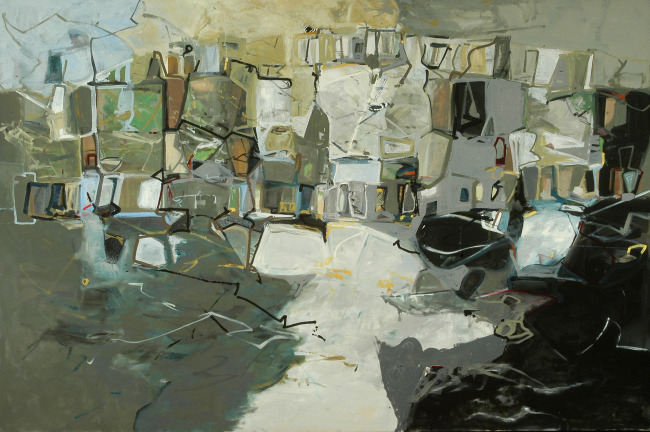Helen Frederick

Walking Bridge 1, 2005, Acrylic on canvas, 4 x 6 ft.
Michael Gross: An Aesthetic Grounded in Gusto and Improvisation by Helen Frederick
Within this exhibition Michael Gross embraces variations on canvas and paper around four themes: Windows, Bridges, Tracks, and Mind’s Eye. The abstractions conveyed by these themes resound with the mature authority of one of Washington’s most passionate painters, one who is distinctive in his ability to interchange color and form and master his selected idiom of abstract expressionism.
He does not do this easily, nor do we view the works without almost the same amount of visual attack that made them. Michael Gross asks us to look at his canvases and works on paper and construct with him a masterful assembly of forms. As soon as I embark on his visual journey, I begin thinking that the artist knows what is behind the shapes he gives us and I do not. Is the white geometric area water or pure abstract shape? Are the lines divisions or interludes? The questioning provides an exhilarating exploration of the inherent improvisational complexities in these exquisite paintings.
This orchestrated complexity in Gross’ paintings and monoprints is not planned in advance. One senses that Gross paints eagerly and constantly. The display of the artist’s hand is palpable: flickering gestural movement embedded with calligraphic lines exists next to compressed and rumbling forms that are massed and fitted together in a painterly masonry. I am transported to a visual tableau in which Jean Tinguely holds conversation with Arshile Gorky.
In “Walking Bridge I” (insert page – cover), expressive washes built up by loosely veiled, patched brushwork co-mingle with tertiary colors to transform into tumbled coiling interlocking forms. Gross tightens and fits the layers of meaning into puzzle-like compositions that articulate his memory of the bridge site.
Many of the Window canvases might be compared to Chinese painting in its devotion to obeying the properties of its media. A certain tenderness and delicacy articulated in “Windows (Mountain View)” allows us to see how fearless this artist is. Implied real objects painted by robust brushwork in the foreground are combined with modulated white-washed scuffled shapes through the grid-like window to evoke a presence that stands apart. This image stirs up wind and rock, joy and stasis, as if the viewer were the painter taking a deep breath and studying all there is to know in the world of perceptual nature, paring it down and painting it with great affection. With a sense for knowing just how much to apply, Gross has seduced us into the view and beyond. We are transfixed by white light and enjoy sustained space.
Perhaps the Track group of paintings can be considered the most “solid.” Yet even here unrelated and created passages are integrated harmoniously. Gross applied his experience of walking around a track at night where he felt the powerful presence of nearby buildings to refine another vision of execution. The Track canvases have a different expectation of color, contrast and expression suggested by night vision, more actualized drawing and concrete space about the site.
The large outstanding canvas “Marching” is a fulfillment of one of Michael’s primary themes. It explores his pursuit of non-objective art that comes from inside the artist’s mind, representing the “mind’s eye.” Indeed the quality of motion in this canvas allows mass, color and line to move simultaneously, yet the velocity also separates all its many parts into introspective areas of reflection. In this way, Michael Gross’ approach to painting accepts chance but relies on distillation.
In 2004, Michael Gross arrived at Pyramid Atlantic to explore new ways to make prints. His series of monoprint investigations produced in our studio allowed him to further experience his deep interest in painterly improvisation. Particularly in the monoprints, Gross enjoys the experimental nature he can create by multiple inkings and runs through an etching press. In the end the sensual layering of shapes and markings delivers a decidedly three-dimensional presence. Gross’ perseverance to allow the unpredictable and to honor the inherent nature of his personal pictorial references is a significant part of his formalist approach.
In all of Gross’ work, the two-dimensional surface becomes a site of intuition and instinct. He chooses acrylic or oil media to create painterly atmospheric or laser-sharp images that all together serve to continue a legacy of non-representational art. The most intriguing experience for the viewer is that within the playing field of each work, a sudden brilliance of focus created by a small dot or square of saturated color holds all the forms together on the canvas. That focal point is like a tensor lamp attracting insects at night. If that brilliance were pulled away like a thread, would it all come tumbling down? Gross unfolds, restructures and reconfigures so this will not happen, but the rich visual experience of all the given cues and wonderment that lies around this question makes the viewing all the more exciting. I suddenly realize that touch of color is a chromatic note in the overture that is Michael Gross’ song, a soulful determinant voice in the world of contemporary painting.